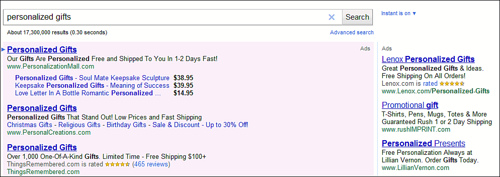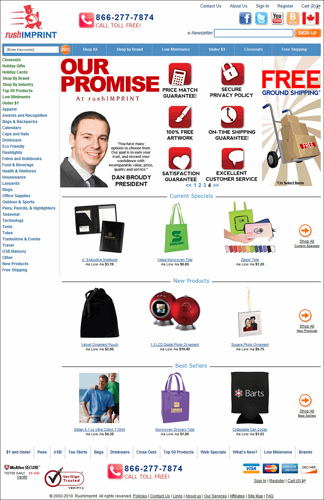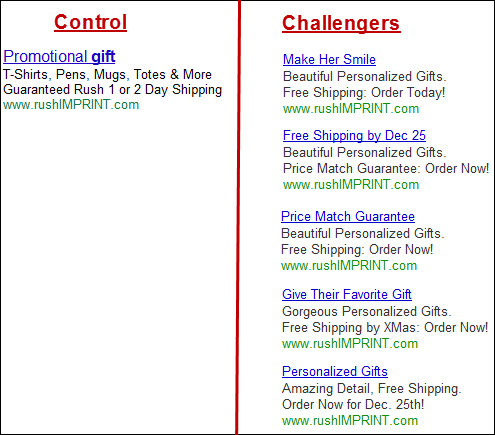When you tell someone new to paid search marketing that they’ll be getting instant feedback, that they’ll have a sea of data at their fingertips, and that the ability to test test test everything you do are powerful advantages to the channel, they invariably want to know “so what, exactly should I test?”
AdWords text ads are small and in some ways unassuming – when you think about testing landing pages it’s obvious that there are elements that could make a big impact, but it’s sometimes less intuitive that ad text tests can and often do have an equally big impact on results.
Let’s walk through some of the specific things you can test to best move the needle on ad text optimizations.
Test Big Ideas First
A majority of the time with ad text optimization the real money improvements lie in major sea-shift changes in concept. Since it’s the holiday season let’s walk through an example of “personalized gifts” and talk a bit about some ad text tests we could set up. Here is the SERP for personalized gifts:

Let’s imagine we’ve been tasked with optimizing ad text for RushImprint.com.
As you’re creating ad text tests, it’s important to understand various factors surrounding the ad text itself, including:
- Your competitors
- The keywords and search queries triggering the ad text
- The landing page that the ad text drives to
We can see the competitors in the SERP listed above, and we’d certainly want to log in to the Rush Imprint AdWords account to understand which keywords and search queries are driving to this particular ad; for the purposes of simplicity in this example, we’ll just try to create a great ad for the term “personalized gifts”.
Next we’ll also want to understand the searcher’s experience when they arrive at our landing page:

Just from this landing page there are some great ideas for ad text tests:
- Free Shipping
- Price Match Guarantee
- Free artwork
There are also some opportunities to get inside the mind of a searcher and see if we can create ad text that resonates. What is this person looking for? What would motivate them to purchase something personalized? What would motivate them to purchase something personalized from us?
Initially, we’ll want to create some tests that offer a few fundamentally different concepts:

The thing to note here is that each of these alternative ad ideas is based on a fundamentally different concept and appeals to an array of different motivations for the searcher. We have some good concepts here, but if we didn’t we could leverage some standard ad copy formats that are often successful. By running these alternative ad concepts, we can get real life feedback on which ads get clicked and which ads convert the best.
In this example we’re using a relatively large number of ads. The keyword we’re testing ad text against is very broad, so a large number of different concepts could potentially resonate best with the searchers – it’s valuable to float a lot of different concepts and appeal to a number of different motivations to learn more about these searchers.
Additionally, we can assume that a broad term like personalized gifts has a reasonable amount of volume, and that we’ll be able to get to statistical significance relatively quickly even with a variety of ads. If you have an Ad Group with a limited amount of volume, it may make more sense to test only two ads so that you can get a definitive winner more quickly. If you’re wondering about the math behind statistical validity, Chad Summerhill has an outstanding ad text validity spreadsheet that will help you pick a winner and be confident that your test is statistically valid.
Drilling Down on a Winning Concept
Once you have a concept that is really effective and a clear winner, you can then drill down to isolate and test specific elements within your concept. Things that you can test include:
- Different supporting benefit statements – If our “Give Their Favorite Gift” text won, we might consider testing the “price match” benefit versus the free shipping to see which is more attractive to searchers, or use different language than the beautiful gifts (perhaps borrowing the enumerated items from the control).
- Different Call to Action – Again assuming our “Give Their Favorite Gift” text is the winner we could test a variety of different things with regards to the call to action, including leaving out the “Xmas” reference, trying to create more urgency by inverting the order of that call to action to be more along the lines of “Order today to Get it By Dec. 25th” (implying they’ll need to order right away to get the gift by Christmas), or other ideas around the call to action.
- Different Display URL – The display URL can sometimes have a non-trivial impact on click-through rate and ultimately conversions. We could try some different things such as:
- Personalized-Gifts.rushIMPRINT.com
- rushIMPRINT.com/Personalized-Gifts
- rushIMPRINT.com/Favorite-Gift
So When Do I Stop Testing Ads?
Never! As you can see above there is a near-infinite number of combinations that you can mix and match, and you should periodically be introducing new ad text concepts on your highest volume ad groups so that you can consistently and iteratively improve upon your ads’ performance. The way that people search changes constantly, and it’s crucial that your ad copy keep up and not leave percentage points in CTR and conversion percentage on the table.





